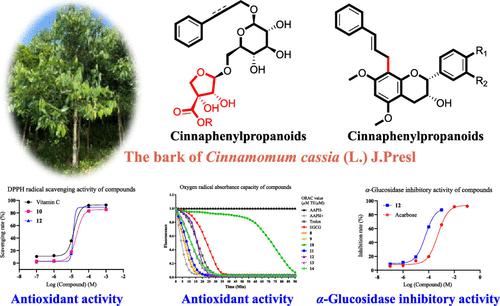Bioactive Phenylpropanoid Glycosides, Dimers, and Heterodimers from the Bark of Cinnamomum cassia (L.) J.Presl
IF 6.2
1区 农林科学
Q1 AGRICULTURE, MULTIDISCIPLINARY
引用次数: 0
Abstract
Six new phenylpropanoid glycosides (1–6), two new phenylethanol glycosides (7 and 8), one new phenylmethanol glycoside (9), three new phenylpropanoid dimers (10–12), two new phenylpropanoid–flavan-3-ol heterodimers (13 and 14), and six known relevant compounds (15–20) were isolated and identified from the well-liked edible and medicinal substance (the bark of Cinnamomum cassia (L.) J.Presl). The structures of these isolates were determined by using spectroscopic analyses, chemical methods, and quantum chemical calculations. Notably, compounds 4–9 were rare apiuronyl-containing glycosides, and compounds 13 and 14 were heterodimers of phenylpropanoids and flavan-3-ols linked through C-9″–C-8 bonds. The antioxidant and α-glucosidase inhibitory activities of all isolates were evaluated. Compounds 10 and 12 exhibited DPPH radical scavenging capacities with IC50 values of 20.1 and 13.0 μM, respectively (vitamin C IC50 value of 14.3 μM). In the ORAC experiment, all these compounds exhibited different levels of capacity for scavenging free radicals, and compound 10 displayed extraordinary free radical scavenging capacity with the ORAC value of 6.42 ± 0.01 μM TE/μM (EGCG ORAC value of 1.54 ± 0.02 μM TE/μM). Compound 12 also showed significant α-glucosidase inhibitory activity with an IC50 of 56.3 μM (acarbose IC50 of 519.4 μM).

肉桂树皮中的生物活性苯丙苷、二聚体和杂二聚体 J.Presl
从深受人们喜爱的食用和药用物质(肉桂(L. )J.Presl 的树皮)中分离并鉴定了 6 个新的苯丙醇苷(1-6)、2 个新的苯乙醇苷(7 和 8)、1 个新的苯甲醇苷(9)、3 个新的苯丙醇二聚体(10-12)、2 个新的苯丙醇-黄烷-3-醇杂二聚体(13 和 14)以及 6 个已知的相关化合物(15-20)。这些分离物的结构是通过光谱分析、化学方法和量子化学计算确定的。值得注意的是,化合物 4-9 是罕见的含 apiuronyl 的苷,化合物 13 和 14 是通过 C-9″-C-8 键连接的苯基丙酮和黄烷-3-醇的杂二聚体。对所有分离物的抗氧化活性和α-葡萄糖苷酶抑制活性进行了评估。化合物 10 和 12 具有清除 DPPH 自由基的能力,其 IC50 值分别为 20.1 和 13.0 μM(维生素 C IC50 值为 14.3 μM)。在 ORAC 实验中,所有这些化合物都表现出了不同程度的清除自由基能力,其中化合物 10 表现出了非凡的自由基清除能力,其 ORAC 值为 6.42 ± 0.01 μM TE/μM(EGCG ORAC 值为 1.54 ± 0.02 μM TE/μM)。化合物 12 还显示出明显的 α-葡萄糖苷酶抑制活性,其 IC50 为 56.3 μM(阿卡波糖 IC50 为 519.4 μM)。
本文章由计算机程序翻译,如有差异,请以英文原文为准。
求助全文
约1分钟内获得全文
求助全文
来源期刊
CiteScore
9.90
自引率
8.20%
发文量
1375
审稿时长
2.3 months
期刊介绍:
The Journal of Agricultural and Food Chemistry publishes high-quality, cutting edge original research representing complete studies and research advances dealing with the chemistry and biochemistry of agriculture and food. The Journal also encourages papers with chemistry and/or biochemistry as a major component combined with biological/sensory/nutritional/toxicological evaluation related to agriculture and/or food.

 求助内容:
求助内容: 应助结果提醒方式:
应助结果提醒方式:


